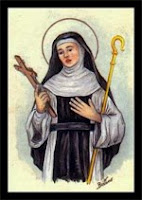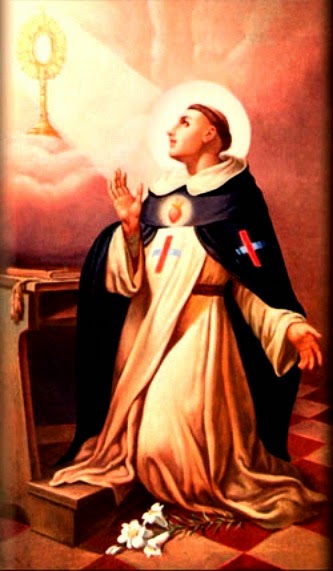St. Elizabeth of Schönau, Benedictine Mystic
St. Elisabeth of Schönau, a friend and correspondent of St. Hildegard of Bingen, became a candid critic of corrupt clergy and joined her in a battle against heresy.
Born in Germany in 1129 of a prominent and pious family, she entered the Black Benedictine double monastery at Schönau, at age 12, made her profession in 1147, and became abbess in 1157.
At the age of 23, she began experiencing ecstasies and visions, which helped to provide answers to theological questions. In addition, she uttered prophecies, as well as denunciations of abuses in the Church and of the Cathari heretics. These revelations usually occurred on Sundays and Holy Days at Mass or Divine Office or after hearing about or reading the lives of saints. Christ, His Blessed Mother, an angel, or the special saint of the day would appear to her and instruct her; or she would see quite realistic representations of the Passion, Resurrection, and Ascension, or other scenes of the Old and New Testaments.
Elisabeth left behind a considerable body of writings: three books of visions, a short text about the Assumption of Mary, visions about the martyrdom of St. Ursula and her companions, The Book of the Ways of God, and some letters. Elisabeth’s brother Ekbert, a priest and monk, who later became the abbot at Schönau, served as her secretary and editor.
After her death in 1165, she was buried in the abbey church of St. Florin. Elizabeth was never formally canonized but was added to the list of saints due to great popular devotion.
Elisabeth's works include three visionary journals (Libri visionem primus, secundus, tercius); parts of these were circulated in her lifetime, but not in their entirety. The three complete works that circulated were these:
Liber viarum Dei (1157), which talks about the "ways of God" followed by men and women in various walks of life --- religious and lay --- and at various stages of life --- childhood, adolescence, widowhood. This work became standard reading in many men's and women's monasteries over the next century.
Revelatio de sacro exercitu virginum Coloniensium (1157), in which Elisabeth reports on her questioning of the "sacred company of the virgins of Cologne": an English princess, Ursula, and her companions. A great number of bones had been discovered in Cologne earlier in the century, and if these were indeed those of the martyrs, then there would be a great number of relics to be distributed. This was by far Elisabeth's most popular work; since she "proved" that the relics were genuine, her report seems to have been wanted by every church and monastery that got a relic.
Visio de resurrectione Beate Virginis Marie (1159), which briefly describes Mary's and an angel's response to questions about a old controversy: whether Mary's body had gone to heaven with her soul at her death. This work appears in at least one extant manuscript circulated before Elisabeth's death and in several shortly after.
Patronage: Against Temptation
St. Elizabeth shares a mystical vision she once had of Mary the mother of Jesus:





Comments
Post a Comment
Comments are moderated and are published at the blogger's discretion.